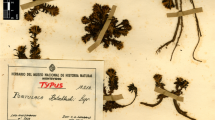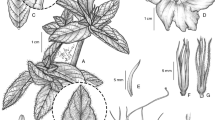Summary
A new species of Neocuatrecasia (Compositae: Eupatorieae: Gyptidinae), N. epapposa, is described and illustrated from the Provincia Ñuflo de Chávez, Departmento de Santa Cruz, eastern Bolivia. The new species is compared with the other low altitude species, N. tysonii, described from the Departmento de Beni, but differs primarily in its epappose achenes with setulae restricted to the stipitate base. It brings the number of herbaceous species in the genus to three, the total number of species to 13, and those known from Bolivia to 6 endemics.


Similar content being viewed by others
References
Bremer, H. & Sander, S. (2000). Inselbergs: Geomorphology and geoecology. In: S. Porembski & W. Barthlott (eds), Inselbergs: Biotic diversity of isolated rock outcrops in tropical and temperate regions. Ecological Studies 146: 7 – 35. Springer-Verlag, Berlin, Heidelberg, New York.
Büdel, B., Becker, U., Follmann, G. & Sterflinger, K. (2000). Algae, fungi, and lichens on inselbergs. In: S. Porembski & W. Barthlott (eds), Inselbergs: Biotic diversity of isolated rock outcrops in tropical and temperate regions. Ecological Studies 146: 69 – 90. Springer-Verlag, Berlin, Heidelberg, New York.
Gröger, A. (2000). Flora and vegetation of inselbergs of Venezuelan Guayana. In: S. Porembski & W. Barthlott (eds), Inselbergs: Biotic diversity of isolated rock outcrops in tropical and temperate regions. Ecological Studies 146: 291 – 314. Springer-Verlag, Berlin, Heidelberg, New York.
Hind, D. J. N. & Frisby, S. (2014). Pectis harryi (Compositae: Heliantheae: Pectidinae), a new species from an inselberg in the Departamento de Santa Cruz, Eastern Bolivia. Kew Bull. 69 (3): 1 – 8. [DOI: 10.1007/S12225-014-9520-2].
____ & Robinson, H. [2006](2007). Tribe Eupatorieae. In: Asterales (J. Kadereit & C. Jeffrey (vol. eds), The Families and Genera of Vascular Plants (K. Kubitzki, series ed.), Vol. VIII. Flowering plants, Eudicots, pp. 510 – 574. Springer-Verlag, Berlin, Heidelberg, New York.
Ibisch, P. L., Rauer, G., Rudolph, D. & Barthlott, W. (1995). Floristic, biogeographical, and vegetational aspects of Pre-Cambrian rock outcrops (inselbergs) in eastern Bolivia. Flora 190 (4): 299 – 314.
Jones, J. P. (1985). The southern border of the Guaporé Shield in western Brazil and Bolivia: An interpretation of its geologic evolution. Precambrian Res. 28 (2): 111 – 135.
King, R. M. & Robinson, H. (1970). Studies in the Eupatorieae (Compositae). XXXII. A new genus, Neocuatrecasia. Phytologia 20 (6): 332 – 333.
____ & ____ (1972). Studies in the Eupatoriae (Asteraceae). LXXXVI. Additions to the genus Neocuatrecasia. Phytologia 24 (2): 105 – 107.
____ & ____ (1974). Studies in the Eupatorieae (Asteraceae). CXIX. Additions to the genera Cronquistianthus, Helogyne and Neocuatrecasia from Peru. Phytologia 27 (6): 395 – 401.
____ & ____ (1986). Studies in the Eupatorieae (Asteraceae). New combinations and new species from Tropical America. Phytologia 60 (1): 80 – 86.
____ & ____ (1987). The genera of the Eupatorieae (Asteraceae). Monogr. Syst. Bot. Missouri Bot. Gard. vol. 22: i – [x], 1 – 581.
____ & ____ (1988). Studies in the Eupatorieae (Asteraceae). CCXXIII. New combinations and new species of Central and South America. Phytologia 65 (1): 62 – 70.
Mamani, F., Pozo, P., Soto, D., Villarroel, D. & Wood, J. R. I. (ed.) (2010). Libro rojo de las plantas de los cerrados del Oriente Boliviana. Industrias Gráficas SIRENA, Santa Cruz.
Mostacedo, B., Toledo, M. & Fredericksen, T. S. (2001). La vegetación de las lajas en la región de Lomerío, Santa Cruz, Bolivia. Acta Amazonica 31 (1): 11 – 25.
Porembski, S., Becker, U. & Seine, R. (2000). Islands on islands: Habitats on inselbergs. In: S. Porembski & W. Barthlott (eds), Inselbergs: Biotic diversity of isolated rock outcrops in tropical and temperate regions. Ecological Studies 146: 49 – 67. Springer-Verlag, Berlin, Heidelberg, New York.
Robinson, H. (2002). Additions to Neocuatrecasia (Eupatorieae: Asteraceae). Novon 12 (3): 388 – 392.
Sánchez, G. N. (1995). Clasificación de la vegetación de la región de Lomerío en el Departamento de Santa Cruz, Bolivia. Proyecto BOLFOR, Santa Cruz. (Documento Técnico 10/1995; USAID Contract: 511-0621-C-00-3027).
Acknowledgements
The author would like to thank John Wood for useful discussions concerning the lajas in the Departamento de Santa Cruz, as well acting as the author’s host during one of the first of the seasons’ collecting trips, in 2008, into the cerrados of Eastern Bolivia as part of the Darwin Initiative Project 16-004, ‘Conservation of the cerrados of eastern Bolivia’ [Conservación de los cerrados del oriente Boliviano] [http://www.darwincerradosdebolivia.org]. It is remarkable how useful grape juice and ice cream can be in stimulating discussion. I would also like to thank Margaret Tebbs for providing the black and white illustration.
Author information
Authors and Affiliations
Corresponding author
Rights and permissions
About this article
Cite this article
Hind, D.J.N. Neocuatrecasia epapposa (Compositae: Eupatorieae: Gyptidinae), a new species from a shield inselberg in the Departamento de Santa Cruz, Eastern Bolivia. Kew Bull 69, 9526 (2014). https://doi.org/10.1007/s12225-014-9526-9
Accepted:
Published:
DOI: https://doi.org/10.1007/s12225-014-9526-9




